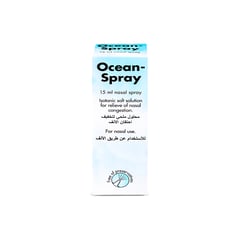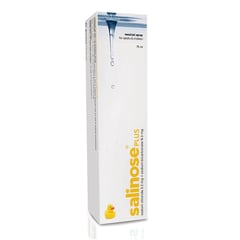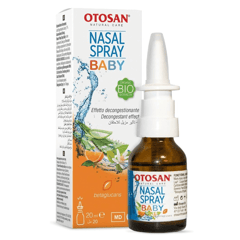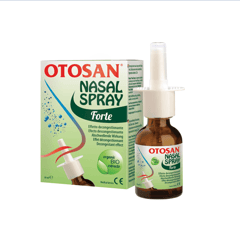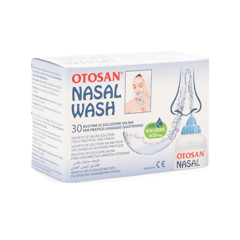Cortrief 64 Mcg/Dose Nasal Spray 120 Doses
45.00

In stock
SKU :
1041-AV078
CORTRIEF is used to treat the effects of allergies, such as hay fever, and inflammation
1. What this product is and what it is used for
CORTRIEF contains a medicine called budesonide. This belongs to a group of medicines
called corticosteroids.
• Corticosteroids help to prevent inflammation.
• CORTRIEF is used to treat the effects of allergies, such as hay fever, and inflammation
inside the nose (rhinitis).
• It can also stop these effects from coming on.
• It is also used to treat small growths inside the nose (nasal polyps). You must talk to a
doctor if you do not feel better or if you feel worse after 14 days.
2. What you need to know before you use this product
Do not use CORTRIEF:
• If you are allergic to budesonide or any of the other ingredients of this medicine (listed in
section 6).
• If you are under 18 years of age. If you are not sure if this applies to you, talk to your doctor
or pharmacist before using CORTRIEF.
Warnings and Precautions
Talk to your doctor or pharmacist before using CORTRIEF if:
• You have TB (tuberculosis).
• You have a chest infection.
• You have reduced liver function.
Contact your doctor if you experience blurred vision or other visual disturbances. If you are
not sure if either of the above apply to you, talk to your doctor or pharmacist before using
CORTRIEF.
Other medicines and CORTRIEF
Tell your doctor or pharmacist if you are taking, have recently taken or might take any
other medicines. This includes medicines that you buy without a prescription and herbal
medicines.
In particular, talk to your doctor if:
• You are taking medicines to treat fungal infections (such as itraconazole or ketoconazole).
• You have been taking steroid tablets. Your doctor may ask you to take fewer of them after
starting to use CORTRIEF. If you notice any unusual effects as a result of this, tell your
doctor.
• You are taking oestrogens and contraceptive steroids.
Pregnancy, breast-feeding and fertility
• If you are pregnant or breast-feeding, think you may be pregnant or are planning to have a
baby, ask your doctor or pharmacist for advice before using this medicine.
• If you get pregnant while using CORTRIEF, talk to your doctor straight away.
Driving and using machines
CORTRIEF is not likely to affect you being able to drive or use any tools or machines.
3. How to use this product.
Always use this medicine exactly as your doctor or pharmacist has told you. Check with your
doctor or pharmacist if you are not sure. Read the label to remind you of what they said.
How much CORTRIEF to use
Allergies such as hay fever
• The recommended dose for adults and the elderly is two sprays of CORTRIEF into each
nostril in the morning. Alternatively, your doctor may ask you to take one spray of CORTRIEF
into each nostril every morning and evening.
• This may be reduced by your doctor once your symptoms have improved.
It is important to use CORTRIEF regularly. Try to use it before you come into contact with
whatever causes the allergy. For example, pollen is what causes hay fever, so you will be
more at risk outdoors.
Nasal polyps
• The recommended dose is one spray of CORTRIEF into each nostril every morning and
evening.
Treatment for allergies such as hay fever and for nasal polyps can continue for up to 3
months.
Use in children
CORTRIEF is not recommended for use in children.
Instructions for use
1. Priming the nozzle
Before using CORTRIEF for the first time, you must prime the nozzle (that
is, fill it with the medicine). To do this:
- Shake the bottle and remove the protective cap.
- Hold the bottle upright as shown in the picture.
- Pump the nozzle up and down several times (5 to 10 times), spraying into
the air until you see an even mist.
The priming effect remains for about 24 hours. If you leave a gap of more
than a day before the next dose, you will need to prime the nozzle again.
This time spray it into the air just once.
2. Using CORTRIEF
• Blow your nose. Shake the bottle. Remove the protective cap.
• Hold the bottle as shown in the picture.
• Put the tip of the nozzle into your nostril, as shown.
• Spray once (or more if the doctor has told you to).
• Use the spray in the other nostril in the same way. Note, you do not need
to breathe in at the same time as you spray.
• Wipe the nozzle with a clean tissue and replace the protective cap. Store
the bottle in an upright position.
3. Cleaning the nozzle
It is best to clean the plastic nozzle of CORTRIEF regularly. Also clean it if you notice that
the spray is not coming out as it should. If this happens, first check the nozzle is primed with
medicine (see “Priming the nozzle” above). If after priming the nozzle again the pump is still
not working, clean the nozzle as follows:
• Remove the plastic nozzle with a clean tissue and wash it in warm (not hot) water.
• Rinse the nozzle thoroughly, dry it and then replace it on the top of the bottle. Never try to
unblock the nozzle by using a pin or other sharp object.
• Prime the nozzle again (by filling it with medicine) before use.
Additional information about using CORTRIEF
• If you are about to have an operation or during times of stress, please tell the doctor that
you use CORTRIEF. The doctor may ask you to take steroid tablets as well, particularly if
you have been taking a high dose of CORTRIEF, or a similar medicine, for a long time.
• Eye problems: If you have an allergy which is also causing eye problems, you may need
to take another medicine as well.
• Long-term treatment: If you use CORTRIEF every day for a long time, your doctor will
need to have a regular check of the inside of your nose (the nasal mucosa).
• Children and adolescents: If a child or adolescent is prescribed CORTRIEF and uses a
high dose for a long time, the doctor will need to check how well they are growing.
If you use more CORTRIEF than you should
It is important that you take your dose as stated on the pharmacist’s label or as advised by
your doctor. You should use only as much as your doctor recommends; using more or less
may make your symptoms worse.
If you take too many doses of CORTRIEF, talk to your doctor or pharmacist straight away.
If you forget to use CORTRIEF
If you forget to take a dose, take it as soon as you remember. However, if it is almost time
to take the next dose, wait until then. Do not use a double dose to make up for a forgotten
dose.
If you stop using CORTRIEF
You may not notice any effects of the medicine for the first few days. Do not stop using this
medicine. Keep taking the medicine as you have been told to. If you still feel no different
after a few more days, talk to your doctor or pharmacist.
If you have any further questions on the use of this medicine, ask your doctor or pharmacist.
4. Possible side effects
Like all medicines, this medicine can cause side effects, although not everybody gets them.
If any of the following happen to you, stop using CORTRIEF and talk to your doctor
straight away:
• Skin rash, itching, lumpy rash (hives), blistering of the skin. Swelling of your face, lips,
tongue or throat (this may make it difficult to swallow). These are uncommon, affecting less
than 1 in 100 people.
• Severe allergic reaction. This is rare, affecting less than 1 in 1000 people.
• In addition to the above, sudden wheezing and/or feeling faint may occur. It is not known
how often these occur; however, they are very unlikely.
If any of the above occurs, you may be having an allergic reaction.
Other possible side effects:
Common (may affect up to 1 in 10 people)
• Occasional sneezing, dry nose, or stinging in your nose. These can happen straight after
using CORTRIEF
• Slight bleeding from the nose.
Uncommon (may affect up to 1 in 100 people)
• Muscle cramps.
Rare (may affect up to 1 in 1000 people)
• Slowing of the rate of growth of children and adolescents. Corticosteroids can affect the
normal production of steroid hormones in your body, particularly if you use high doses for a
long time. This is much less likely to happen with inhaled corticosteroids than with corticosteroid
tablets.
• Perforation of the membrane separating the nostrils (the nasal septum).
• Nasal ulcer.
• Loss of voice.
• Bruising of the skin.
• Blurred vision
Very rare (may affect up to 1 in 10,000 people)
• Sore patches on the inside of the nose
Not known (frequency cannot be estimated from the available data)
• Glaucoma (increased pressure in the eye).
• Cataract.
If any of these side effects occur, they usually go away after a short time.
5. How to store this product
• Keep this medicine out of the sight and reach of children.
• Do not use this medicine after the expiry date which is stated on the carton or label. The
expiry date refers to the last day of that month.
• Store below 30°C.
• Do not freeze
• Shelf life after first opening is 30 days
• Store the bottle in an upright position.
• Do not throw away any medicines via wastewater or household waste. Ask your pharmacist
how to throw away medicines you no longer use. These measures will help to protect the
environment.
1. What this product is and what it is used for
CORTRIEF contains a medicine called budesonide. This belongs to a group of medicines
called corticosteroids.
• Corticosteroids help to prevent inflammation.
• CORTRIEF is used to treat the effects of allergies, such as hay fever, and inflammation
inside the nose (rhinitis).
• It can also stop these effects from coming on.
• It is also used to treat small growths inside the nose (nasal polyps). You must talk to a
doctor if you do not feel better or if you feel worse after 14 days.
2. What you need to know before you use this product
Do not use CORTRIEF:
• If you are allergic to budesonide or any of the other ingredients of this medicine (listed in
section 6).
• If you are under 18 years of age. If you are not sure if this applies to you, talk to your doctor
or pharmacist before using CORTRIEF.
Warnings and Precautions
Talk to your doctor or pharmacist before using CORTRIEF if:
• You have TB (tuberculosis).
• You have a chest infection.
• You have reduced liver function.
Contact your doctor if you experience blurred vision or other visual disturbances. If you are
not sure if either of the above apply to you, talk to your doctor or pharmacist before using
CORTRIEF.
Other medicines and CORTRIEF
Tell your doctor or pharmacist if you are taking, have recently taken or might take any
other medicines. This includes medicines that you buy without a prescription and herbal
medicines.
In particular, talk to your doctor if:
• You are taking medicines to treat fungal infections (such as itraconazole or ketoconazole).
• You have been taking steroid tablets. Your doctor may ask you to take fewer of them after
starting to use CORTRIEF. If you notice any unusual effects as a result of this, tell your
doctor.
• You are taking oestrogens and contraceptive steroids.
Pregnancy, breast-feeding and fertility
• If you are pregnant or breast-feeding, think you may be pregnant or are planning to have a
baby, ask your doctor or pharmacist for advice before using this medicine.
• If you get pregnant while using CORTRIEF, talk to your doctor straight away.
Driving and using machines
CORTRIEF is not likely to affect you being able to drive or use any tools or machines.
3. How to use this product.
Always use this medicine exactly as your doctor or pharmacist has told you. Check with your
doctor or pharmacist if you are not sure. Read the label to remind you of what they said.
How much CORTRIEF to use
Allergies such as hay fever
• The recommended dose for adults and the elderly is two sprays of CORTRIEF into each
nostril in the morning. Alternatively, your doctor may ask you to take one spray of CORTRIEF
into each nostril every morning and evening.
• This may be reduced by your doctor once your symptoms have improved.
It is important to use CORTRIEF regularly. Try to use it before you come into contact with
whatever causes the allergy. For example, pollen is what causes hay fever, so you will be
more at risk outdoors.
Nasal polyps
• The recommended dose is one spray of CORTRIEF into each nostril every morning and
evening.
Treatment for allergies such as hay fever and for nasal polyps can continue for up to 3
months.
Use in children
CORTRIEF is not recommended for use in children.
Instructions for use
1. Priming the nozzle
Before using CORTRIEF for the first time, you must prime the nozzle (that
is, fill it with the medicine). To do this:
- Shake the bottle and remove the protective cap.
- Hold the bottle upright as shown in the picture.
- Pump the nozzle up and down several times (5 to 10 times), spraying into
the air until you see an even mist.
The priming effect remains for about 24 hours. If you leave a gap of more
than a day before the next dose, you will need to prime the nozzle again.
This time spray it into the air just once.
2. Using CORTRIEF
• Blow your nose. Shake the bottle. Remove the protective cap.
• Hold the bottle as shown in the picture.
• Put the tip of the nozzle into your nostril, as shown.
• Spray once (or more if the doctor has told you to).
• Use the spray in the other nostril in the same way. Note, you do not need
to breathe in at the same time as you spray.
• Wipe the nozzle with a clean tissue and replace the protective cap. Store
the bottle in an upright position.
3. Cleaning the nozzle
It is best to clean the plastic nozzle of CORTRIEF regularly. Also clean it if you notice that
the spray is not coming out as it should. If this happens, first check the nozzle is primed with
medicine (see “Priming the nozzle” above). If after priming the nozzle again the pump is still
not working, clean the nozzle as follows:
• Remove the plastic nozzle with a clean tissue and wash it in warm (not hot) water.
• Rinse the nozzle thoroughly, dry it and then replace it on the top of the bottle. Never try to
unblock the nozzle by using a pin or other sharp object.
• Prime the nozzle again (by filling it with medicine) before use.
Additional information about using CORTRIEF
• If you are about to have an operation or during times of stress, please tell the doctor that
you use CORTRIEF. The doctor may ask you to take steroid tablets as well, particularly if
you have been taking a high dose of CORTRIEF, or a similar medicine, for a long time.
• Eye problems: If you have an allergy which is also causing eye problems, you may need
to take another medicine as well.
• Long-term treatment: If you use CORTRIEF every day for a long time, your doctor will
need to have a regular check of the inside of your nose (the nasal mucosa).
• Children and adolescents: If a child or adolescent is prescribed CORTRIEF and uses a
high dose for a long time, the doctor will need to check how well they are growing.
If you use more CORTRIEF than you should
It is important that you take your dose as stated on the pharmacist’s label or as advised by
your doctor. You should use only as much as your doctor recommends; using more or less
may make your symptoms worse.
If you take too many doses of CORTRIEF, talk to your doctor or pharmacist straight away.
If you forget to use CORTRIEF
If you forget to take a dose, take it as soon as you remember. However, if it is almost time
to take the next dose, wait until then. Do not use a double dose to make up for a forgotten
dose.
If you stop using CORTRIEF
You may not notice any effects of the medicine for the first few days. Do not stop using this
medicine. Keep taking the medicine as you have been told to. If you still feel no different
after a few more days, talk to your doctor or pharmacist.
If you have any further questions on the use of this medicine, ask your doctor or pharmacist.
4. Possible side effects
Like all medicines, this medicine can cause side effects, although not everybody gets them.
If any of the following happen to you, stop using CORTRIEF and talk to your doctor
straight away:
• Skin rash, itching, lumpy rash (hives), blistering of the skin. Swelling of your face, lips,
tongue or throat (this may make it difficult to swallow). These are uncommon, affecting less
than 1 in 100 people.
• Severe allergic reaction. This is rare, affecting less than 1 in 1000 people.
• In addition to the above, sudden wheezing and/or feeling faint may occur. It is not known
how often these occur; however, they are very unlikely.
If any of the above occurs, you may be having an allergic reaction.
Other possible side effects:
Common (may affect up to 1 in 10 people)
• Occasional sneezing, dry nose, or stinging in your nose. These can happen straight after
using CORTRIEF
• Slight bleeding from the nose.
Uncommon (may affect up to 1 in 100 people)
• Muscle cramps.
Rare (may affect up to 1 in 1000 people)
• Slowing of the rate of growth of children and adolescents. Corticosteroids can affect the
normal production of steroid hormones in your body, particularly if you use high doses for a
long time. This is much less likely to happen with inhaled corticosteroids than with corticosteroid
tablets.
• Perforation of the membrane separating the nostrils (the nasal septum).
• Nasal ulcer.
• Loss of voice.
• Bruising of the skin.
• Blurred vision
Very rare (may affect up to 1 in 10,000 people)
• Sore patches on the inside of the nose
Not known (frequency cannot be estimated from the available data)
• Glaucoma (increased pressure in the eye).
• Cataract.
If any of these side effects occur, they usually go away after a short time.
5. How to store this product
• Keep this medicine out of the sight and reach of children.
• Do not use this medicine after the expiry date which is stated on the carton or label. The
expiry date refers to the last day of that month.
• Store below 30°C.
• Do not freeze
• Shelf life after first opening is 30 days
• Store the bottle in an upright position.
• Do not throw away any medicines via wastewater or household waste. Ask your pharmacist
how to throw away medicines you no longer use. These measures will help to protect the
environment.
| Shipping Type | Express |
|---|
Write Your Own Review
The largest selection of casino games and sports bets at 1xbet app.



